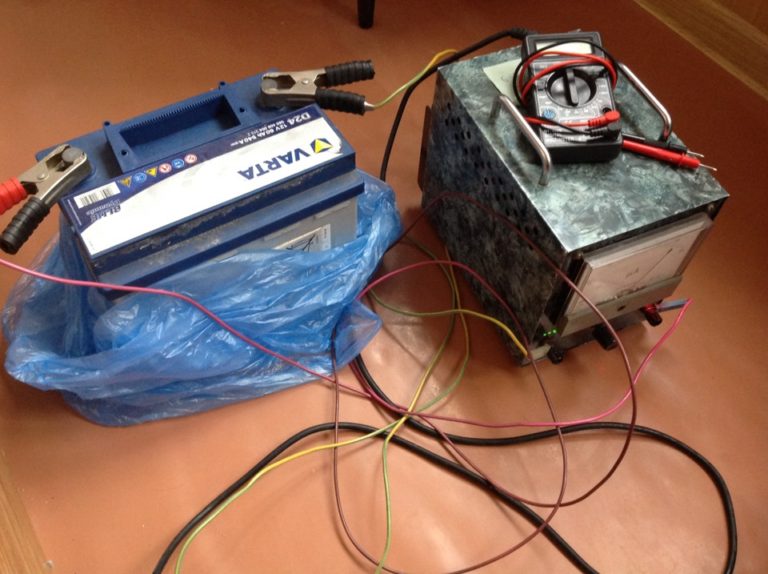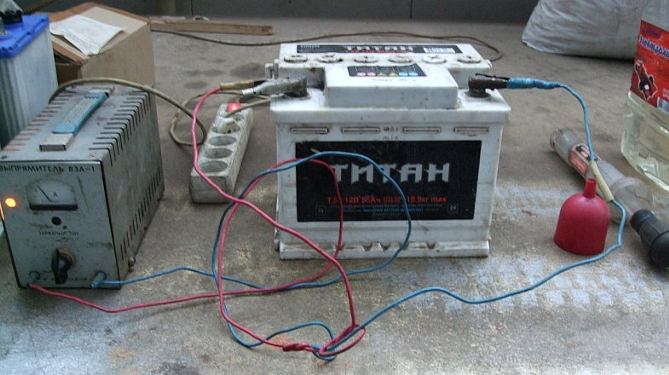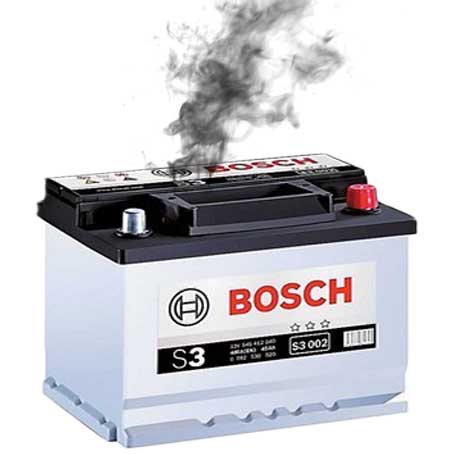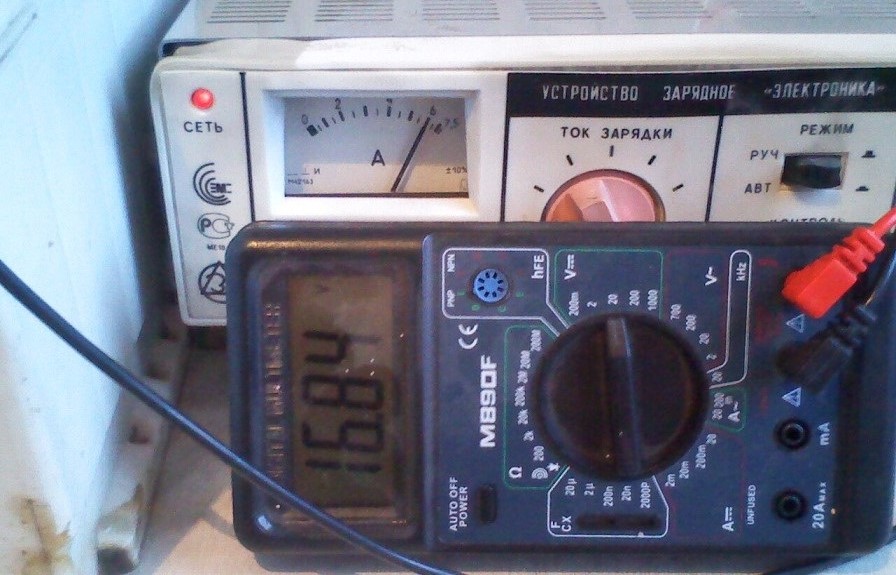Charging maintenance-free batteries must be done with extreme caution. After all, implement Measuring the electrolyte density of such batteries is impossible. Therefore, you should take into account the situation that led to the need to charge the battery, as well as the level of residual voltage. Note that recharging the battery is not a rare procedure. After all, any battery sometimes requires charging. It is a mistake to rely on one generator.
The first and most important condition when charging a battery is to observe the polarity on the battery itself and charger . After all, not every device has protection against accidental polarity reversal. The room where the battery is charged must be well ventilated or ventilated. After all, the gases released during battery charging are harmful to health.
A high-quality and progressive charger is able to determine the current state of the battery and select the current required for charging. A good charger can cost a car owner 6-8 thousand rubles.
Before charging the battery, you should also clean it of dirt. After all, dirt can shunt the charge current, that is, conduct current, which is not at all good. In addition, the battery begins to accept a charge only after the electrolyte has warmed up to a positive temperature. Therefore, after bringing the battery into the room from the cold, it needs to be allowed to warm up.
Charging a partially discharged maintenance-free car battery

In this situation, the battery is charged by applying continuous voltage. The task of the charger in this case is to control the current strength. The device must supply a voltage of 14-14.5 Volts to the battery with a current of 25 Amps at the start of charging.
battery passenger car with this charging mode it can charge in enough time short term- 3 hours. In this case, it is necessary to monitor the process. The charging current should drop to 0.2 A in the case of a full charge. However, this is in theory. In practice, you cannot charge a battery with a current that is greater than 15 Amps.
Charging a maintenance-free car battery in case of complete discharge
This situation is more complex. It will take about a day to solve this problem. At the same time, it is also necessary to monitor the process. The charger must be set to a current equal to 10% of the capacity of the battery being charged in Ah. After all, when the battery is fully charged, gas forms on the plates, so the entire electrolyte can turn into gas. This is already dangerous. After all, there are no holes in the battery case, so it is quite likely to rupture.
Charging the battery in a car

You can charge a maintenance-free type battery without removing it from the car or turning off everything. electronic devices. IN in this case it will also require attention from the owner of the car, as well as strict adherence to instructions. In case of excessive gas evolution, stop charging. After charging is complete, be sure to measure the voltage. It must correspond to the nominal value.
As you can see, the battery can be charged both in the car and outside it. However, in the first case, you should monitor the process more carefully. In addition, this method requires easier access to the battery. You also need to think about sensitive electronics when charging in your car. The car's ignition should not be turned on; it should be put into sleep mode. By removing the battery, you can reset all existing machine settings.
The battery must be charged only at positive temperatures. When charging in the car, you should go into a warm garage. If the battery is charged after being removed from the car, then it is necessary to protect it from tipping over, and also to ensure the ability to quickly turn off the charger.
- The battery “likes” to be fully charged and also in the cold. After all, a cold battery has less self-discharge.
- If you place a charged battery on a constant recharge with a current that is equal to its self-discharge current, then the battery will be fully charged at any moment. Moreover, there will be no harm from such a procedure.
- If the battery is installed on the car, then it is better if it is charged by 90-95%. Indeed, in this case, with unpredictable voltage surges in on-board network machine (due to a breakdown of the relay-regulator, etc.), the battery, like a capacitor, will be able to absorb an excessive surge of electricity. As a result, such an incident will not affect all electrical appliances in the car.
How to charge maintenance free battery car - this is the question that worries every car enthusiast who has decided to change the "capricious" lead battery to a more modern battery.
Maintenance-free car batteries - types and features
Maintenance-free batteries are currently very popular among drivers, since they do not require them to constantly monitor the electrolyte level in the battery and periodically top it up. Essentially, you purchase and install one on your vehicle, with which there is no hassle during operation. What car enthusiast can refuse such a tempting offer?
There are three types of such maintenance-free batteries:
- Batteries with a standard liquid electrolyte, which either do not have plugs on the case at all intended for adding distilled water, or are sealed.
- Gel. In them, a special powder made from silicon oxide is impregnated with an electrolyte until a mass is formed white, which is then placed in the insides of the battery, completely filling them with itself.
- Batteries with non-woven polypropylene saturated with liquid electrolyte.

Note that the pioneers of maintenance-free designs for starting vehicle engines were lead-calcium batteries, which did not require the addition of water for 1.5–2 years. They did not gain real popularity for the reason that they quickly failed if they were actively used.
Is it necessary to charge a maintenance-free car battery?
To this question, which arises among novice motorists no less often than the question of how to charge a maintenance-free car battery, experts unequivocally answer that, of course, charging is necessary. By and large, they are constantly in self-charging mode. At the same time, such recharging of the battery from a generator is inherently a much more “harsh” process for the battery than gentle charging it with a special device.

In some situations, you simply cannot do without charging a maintenance-free battery.
For example, when the first cold weather arrives, the lubricant in the engine becomes thicker. Naturally, the starter requires more effort to spin the engine. And where will it get energy if for 6-7 months your battery was half charged and that was enough for it? This is why professionals advise attacking winter season charge the battery to one hundred percent, and then go on any long-distance journey without fear.

How to charge a maintenance-free car battery?
The process can be carried out in two different modes:
- when the battery is completely discharged;
- with partial discharge.

If the battery is completely discharged, it will have to be “recharged” for about 24 hours. Charging in such a situation is performed with a current intensity that is 10 times less than that recommended by the battery manufacturer. You will have to monitor the process. The battery will be considered charged when a strong gas emission is detected on its plates. After disconnecting the charger, you need to check the voltage at the battery terminals. It should be 12 V.

For partial discharge, a 25 A charger is used, which is capable of delivering a continuous voltage of 13.9 to 14.9 V. Fully charged In this case, the battery is noted after 150–180 minutes. The charger signals the need to stop the operation. With a fully charged battery charging current will drop to 0.2 A. We hope you now have a clear answer to the question of how to charge a maintenance-free car battery.
A maintenance-free type battery differs from a maintenance-free classic acid power source solely in its design. The thing is that it is impossible to add distilled water or electrolyte to such a battery, since it functions completely autonomously without any maintenance. But, most vehicle owners who have purchased a maintenance-free energy source are interested in the question: can it be charged, and if so, how to properly charge a maintenance-free battery?
Does a maintenance free battery require charging or not?
In any case, the battery needs periodic charging, because regardless of its type, that is what it is designed for (acquiring and releasing charge).
To begin with, it is worth remembering the principle of giving and consumption electrical energy in the on-board network of the vehicle. To start power unit energy is required from the power source, which is supplied to the starter and ignition system fuel mixture. After the engine is started, the generator is turned on, which generates the necessary energy to ensure the battery charging process.

No matter what type of battery is installed on the vehicle, you need to understand that it still requires recharging to replenish the energy spent on starting the power unit. Moreover, if you completely discharge a maintenance-free lead battery several times, it will simply fail. That is why it is impossible to do without constant battery recharging.
What is the essence of the problem?
If recharging the battery from a car generator is normal, then, in the opinion of most motorists, restoring the battery capacity using a stationary charger is extremely detrimental to it.
Why do many people think this way:
- — It is impossible to see when the electrolyte has boiled, since the jars of a maintenance-free power source are hermetically sealed, and it is impossible to track what processes are occurring in them. Since the battery is completely sealed, this point is very alarming for car owners when charging the battery, since when the electrolyte boils, its vapors will not be able to leave the battery case, as a result of which it can simply explode from the resulting pressure.
- — There is no possibility of density control. For example, if in a serviced type of battery it is quite simple to measure it: just unscrew the plugs and put a hydrometer in the battery jars, then in an unmaintained type it will no longer be possible to do this.
Based on the points described above, it is necessary to draw up detailed algorithm charging a maintenance-free power source in order to understand what subtleties and nuances should be taken into account in this process.
Features of the charging process in a maintenance-free power source
Note that no primitive methods, homemade chargers or the “I’ll leave it to charge overnight” principle are suitable for its implementation. There are two real ways to restore the capacity of a maintenance-free battery:
- Charging at constant voltage. Its process proceeds with a predetermined voltage value, for example 14V, and the current constantly changes in automatic mode. At the beginning of the process, the charging current can reach 8-10 A, and at the end - 0.1-0.4 A.
- Charging at constant current. It differs from the first method only in that the voltage changes here, but the charging current does not change throughout the entire process.
All power sources are charged in this way.
How long does it take to charge?
The question is the most interesting. Naturally, it is necessary to clearly calculate the time required to charge the battery. To do this correctly, you should know how low the battery is. To do this, you need to learn how to calculate its capacity. Let's describe how to do this.

It is known that 12.7V is the value of the full charge of the power source, and if the battery is completely discharged, its voltage will not exceed the threshold of 11.7V. Note that 10V is a critical figure for the charge of the power source, which should not be allowed. There is a difference of 10% between the values of full charge and discharge of the battery, and it is 1V.
Let's consider the concept of power supply capacity. Often it is 55-60-75 A/h, and then increasing. This concept characterizes the amount of current that the power source can deliver for 60 minutes. If accumulator battery with a capacity of 60 A/h is only half charged, the value of its capacity in this one is only 30 A/h.
In order to completely restore the entire capacity of the battery, a charging current of a certain strength must be applied to its terminals. Some believe that in order to replenish half the capacity of the battery described in the example, it will be necessary to supply it with a charging current of 30A. However, this will completely destroy the power supply. It must be charged by applying a charging current, the value of which does not exceed 10% of the battery capacity. That is, our battery requires a charging current of 6A. Now you need to determine the charging time.
Since 30A is required to fully replenish the battery capacity, while the charging current is 6A, this follows a simple formula - 30/6=5. That is, it will take 5 hours to restore the capacity of the power source.
Using automatic chargers
Their use is most justified, since there is no need to calculate the battery capacity, current value and charging time, etc. The automatic charger will do everything itself. For example, at the beginning of charging, the current supplied to the battery will have a maximum permissible value, which will begin to decrease over time.

A maintenance-free battery will never boil because the system constantly monitors and reduces the charging current.
How bad is recharging?
The process of recharging any power source is accompanied by the mandatory boiling of the electrolyte inside it. This causes the formation of gas and an increase in pressure, which can cause the battery to simply explode. Maintenance-free batteries have a special valve that opens in this case. And although the battery case will remain intact, overcharging will still harm such a battery, since the electrolyte will evaporate from it, and it will no longer be possible to replenish its quantity.

Manufacturers have made it easier for users to charge unattended sources power supply by placing a special signaling device on their body. Its color indicates the different states of the battery. For example, green color indicates that the battery is fully charged, and black indicates the need to replenish its capacity.
How safe is it to charge a maintenance-free battery at home?
Yes, a serviced battery cannot be charged at home, since this process is always accompanied by the formation of a caustic gas.
WITH maintenance-free type power supplies, things are simpler. The main thing is not to recharge them for a long time, but otherwise charging process even in an apartment it is quite safe. It is enough to turn off the charger as soon as the indicator lights up green, and you don’t have to wait full time to charge the battery.
Hello everyone, readers and subscribers of my autoblog! In previous publications, we have already looked at the main problems that may occur to a driver in the event of. Here’s another common situation: how to charge a maintenance-free battery? There are many recommendations and myths on this topic. Some of them are so abstruse that it can be difficult for the average car enthusiast to understand the essence of the process. Let's try to explain this in accessible language.
You need to understand the difference between a serviceable battery and a non-serviceable one. In the case of the latter, the driver does not have to add electrolyte to it, monitor its level in the banks or measure the density. That is why it received such a name in everyday life. Each time the engine is started, it will lose part of its capacity, and the process of its restoration will depend on how often the vehicle is used. Therefore, to the question of whether such a battery needs to be charged, the answer will be unequivocal - it is necessary.
From the very beginning, you need to establish the approximate age of the car battery. If the battery lasts for more than 5 years, then don't even waste time on it. You will not be able to restore its charge for a long time, so it is better to scrap it and buy a new one. When we talk about maintenance-free products, we must understand that we will not be able to track the process of boiling off the electrolyte during charging. That is, you will have to figure out how much to charge in time only by looking at the clock.
There are also some risks associated with the release of vapors and gases. If the electrolyte boils, the battery may simply rupture. That is why it is necessary to detect the beginning and end of this process. It is especially unsafe when the driver tries to restore capacity in a short time and immediately supplies a large current. This will simply “kill” the battery, and nothing good will come to it. 
Therefore, fully automated workstations have appeared on sale, which are no longer equipped with either a voltmeter or an ammeter. The driver does not need to know anything about these parameters. They themselves calculate the current and voltage at various stages and regulate them, making them either less or more. Whether they charge more efficiently than traditional devices is unknown, but they are safer to use - that’s a fact. Therefore, with such a device you don’t have to worry about the electrolyte boiling - the charger will simply turn off automatically when the critical temperature is reached.
Instructions for restoring battery capacity on your own
And now a detailed algorithm of actions on how to properly charge a maintenance-free battery:

How to calculate the duration of the charging procedure
At home, car batteries are charged using automatic chargers. For such batteries, their degree of charge will depend on the voltage supplied by the device. We answer the question, how long will it take for such a process? A 12-volt battery is restored to 90% of its previous capacity using a voltage of 15 volts per 24 hours.
 A good device automatically installs a program to restore battery capacity. It not only controls the current, but also selects the necessary voltage to achieve maximum effect. Before connecting, do not forget to make sure that the minus is connected to the negative terminal, and the plus is connected to the plus. The red terminal is always attached to the “plus” of the battery, while the black terminal is always attached to the “-”.
A good device automatically installs a program to restore battery capacity. It not only controls the current, but also selects the necessary voltage to achieve maximum effect. Before connecting, do not forget to make sure that the minus is connected to the negative terminal, and the plus is connected to the plus. The red terminal is always attached to the “plus” of the battery, while the black terminal is always attached to the “-”.
If you use such a device at home or in the garage, make sure that the room is properly ventilated. During charging, chemically unsafe substances may be released into the atmosphere, which there is absolutely no need to inhale.
In general, it is not recommended to charge the battery in rooms where people are constantly present, that is, at home. IN as a last resort do this on a loggia or balcony, be sure to open the window to the street.
And finally, one more small recommendation. We have roughly figured out how long it takes to charge a standard battery. However, automatic device costs some money, and therefore if this process is in demand only from time to time, then it makes sense to turn to specialized car services, where you can recharge for a small fee. Also in the continuation of this topic you can find out why
Maintenance-free batteries have arrived, which are everywhere installed on new ones. vehicles. A high-quality, maintenance-free battery provides uninterrupted operation throughout the entire declared service life (3-5 years) and assumes maximum ease of use during operation. The main advantage can be considered what lies in the name of such a battery - there is no need to maintain the car battery, that is, there is no longer a need to periodically measure the electrolyte density and add distilled water.
In parallel with this, maintenance-free batteries require certain manipulations, which include timely recharging of such batteries, especially before the onset of cold weather.
As a result, many car enthusiasts have a number of questions, the main ones being topics regarding maintenance and charging of maintenance-free batteries. Maintenance should be understood as maintaining the proper charge level to avoid deep discharge of the battery. Next, we will look at whether it is possible to charge a maintenance-free car battery and how to charge maintenance-free batteries correctly.
Charging maintenance-free car batteries
Let's start with the fact that charging a maintenance-free car battery is somewhat different from charging its lead-acid counterparts. The thing is that the manufacturing technology of maintenance-free batteries can be different. Such solutions may have a conventional electrolyte, which is poured into the housing, but the so-called “jars” are hermetically sealed, that is, there is structurally no access for adding water. The plate material also differs from the solutions used in lead batteries.
Another type of battery does not have liquid electrolyte inside the battery in the form in which many drivers are accustomed to seeing it. The electrolyte in the housing is held in special material(polypropylene). Separately stand the so-called gel batteries. The design of such solutions requires the presence of an electrolyte that is mixed with silicon oxide. The specified silicon oxide is poured in the form of a powder, resulting in the formation of a gel inside the battery case. This gel fills the interior space of a maintenance-free gel battery.
Regarding recharging, maintenance-free battery also needs periodic replenishment of charge, like a regular one. In both cases, the charge from the generator alone is not enough, especially during short trips, when the energy spent on starting simply does not have time to be replenished. For this reason, it is simply necessary to recharge the battery with a special charger, especially before the onset of cold weather.
Any battery with low temperatures discharges faster, the lubricant in the engine itself thickens, and the fuel evaporates worse. It is quite obvious that it is much more difficult to crank the starter in such conditions. Moreover, in cold weather, more power is supplied to the starter starting current. If the engine started easily in summer even with a half-discharged battery, then in winter the battery may be discharged already on the second attempt to start. Taking into account these features, you should fully charge the battery, that is, increase the charge to the maximum battery capacity. In this case winter operation will not cause problems for the owner even if it is difficult to start the internal combustion engine in extreme cold.
Nuances when charging a maintenance-free car battery

When charging batteries of this type Attention should be paid to the following points:
- inability to measure the density of the electrolyte using a hydrometer;
- sealed housing, which does not allow fast charging high currents;
At the very beginning, you should place the battery on a flat, hard and securely fixed surface to prevent the possibility of tipping over during charging.
Before charging, the residual voltage must be determined. A partially or completely discharged, maintenance-free battery should be charged at continuous voltage. You will need to set the current on the charger. The charger should supply a voltage of 14-14.5 V to the terminals, and the current should not exceed 2 amperes at the start.
A little shabby car battery A passenger car in such conditions will be fully charged in 3-4 hours. Note that in some cases, when using a charger, control over the charging process is necessary. Full charging occurs when the charging current drops to 0.2 A. Note that charging the battery with a current of more than 15 A is prohibited! Also, there is no way to allow the voltage at the terminals of a maintenance-free battery to increase above 15.5 volts.
In the case of a deep discharge (the battery is completely dead), it will take more time (about a day or up to 30 hours) to charge. Let us add that usually deep discharge not allowed for maintenance-free batteries. In practice, 1 or 2 such digits do not greatly affect operational properties batteries good quality. The charger should be set to a voltage that is 1/10 V Ah of the total capacity of a particular battery.
During charging, you should carefully monitor the process, as the electrolyte may begin to boil away. The closed housing will not allow excess to escape, which can lead to an explosion, fire and other consequences. If active seething or boiling is noticed inside the battery, then charging should be stopped immediately. Also, after charging, you should additionally check the voltage at the battery terminals, which must correspond to the standard.
Taking into account the risks described above, it is not recommended to charge the battery directly on the car, since the charging process (especially of a completely discharged battery) will require careful monitoring. In case of complications, there must be free access to the battery itself, and it must also be possible to quickly de-energize the charger. If you decide to charge the battery without removing it from the car, then be sure to turn off the power consumers that provide this possibility and remove the key from the ignition before starting the charging process. Let us add that it is better to use a warm room for charging, rather than connecting the charger to the battery through an extension cord directly outside at subzero temperatures.
Similar articles
During engine operation, the rechargeable battery (battery), regardless of the type (maintained or... Charging the battery with a charger.



